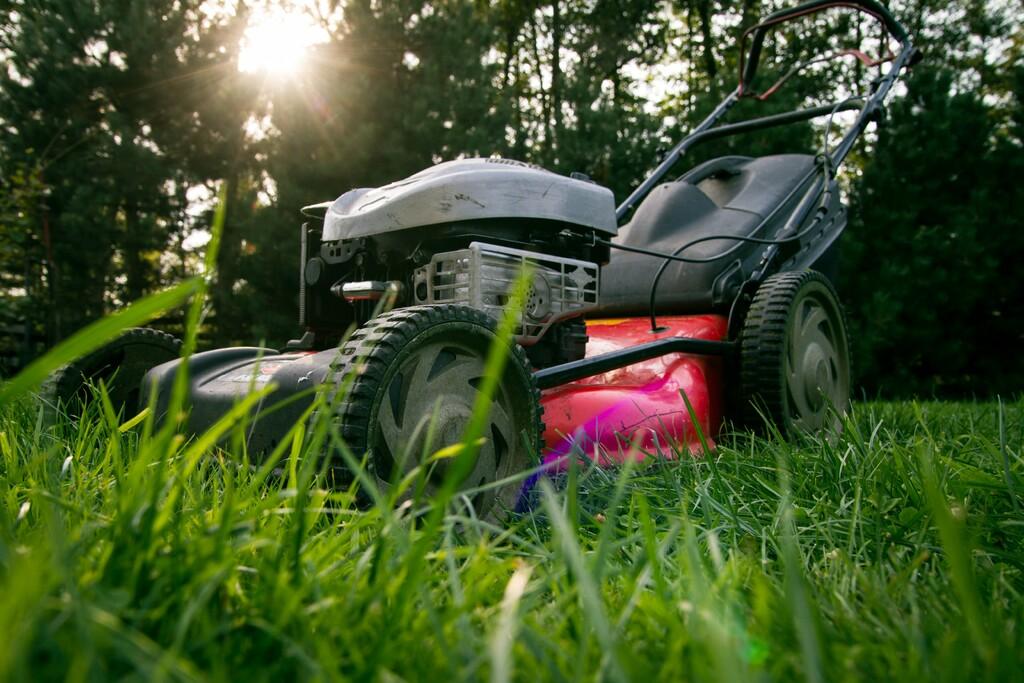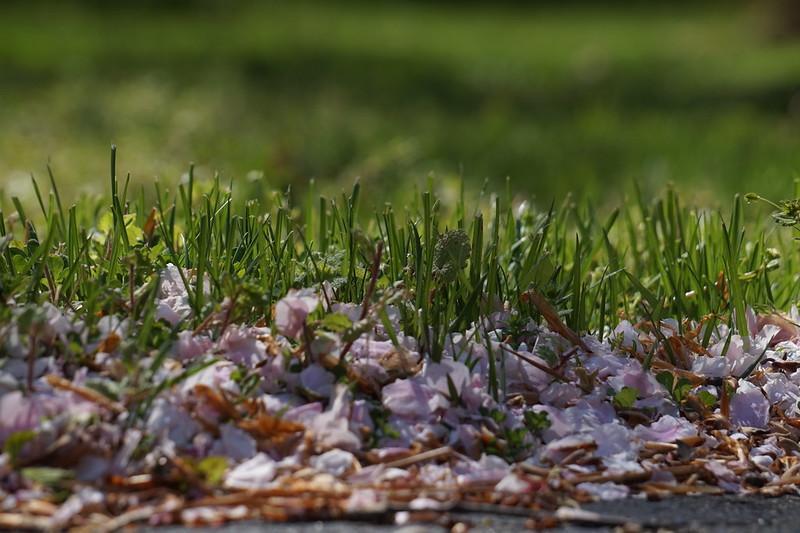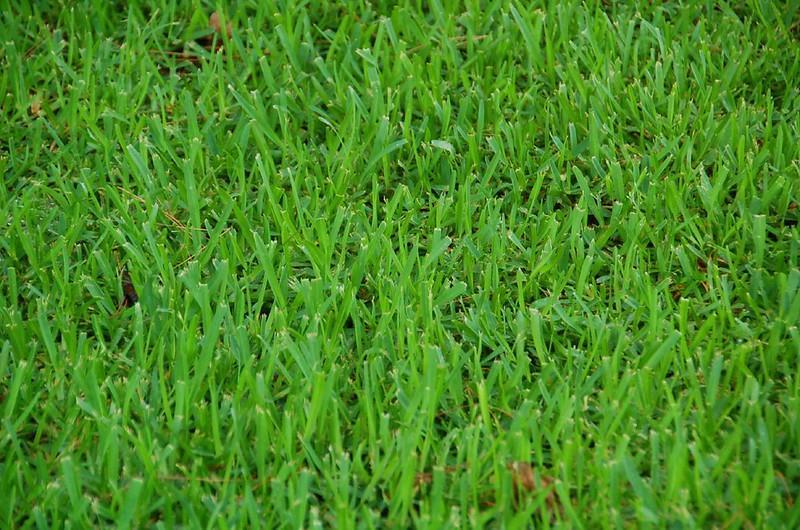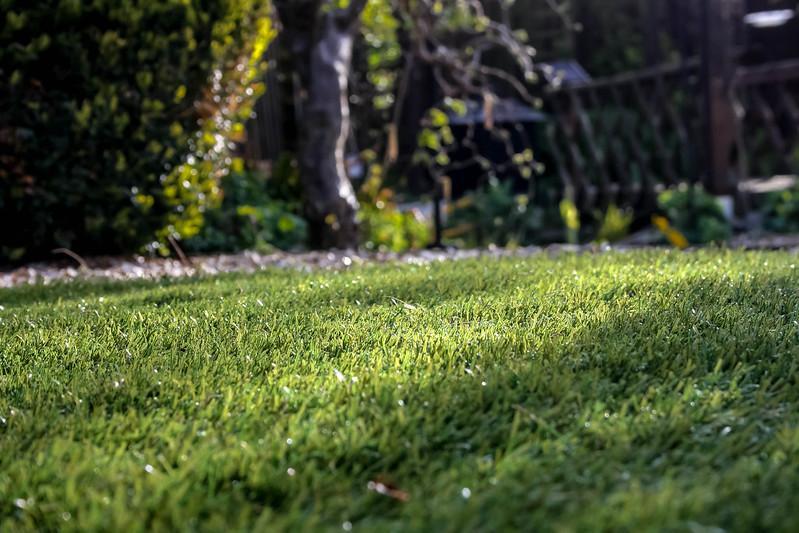Mowing, weeding, dethatching, reseeding, and aerating a lawn are just a few of the labor-intensive tasks that are required to maintain a lovely lawn. All of this makes taking care of a lawn a time-consuming commitment. In this article, let’s take a look at no mow grass types.

According to the EPA, gas lawn mower emissions make up about 5% of the country’s air pollution.
So, if you are tired of spending hours every week taking care of your lawn, grass varieties that do not need to be mowed (often or at all) might be an excellent choice. Not only will it help you save time but also on lawn care costs.
The reason that no-mow grasses work is that they either grow very slowly or have a maximum height that does not need mowing.
Sounds intriguing? Read on to learn more!
Best No-Mow Grass Types
1. Fescue Grass

Fescues are one of the most adaptable grasses known for their high tolerance for extreme conditions.
Best Time To Plant: late summer to early fall
Hardiness Zone: 4 to 8
Ideal Soil PH: 4.5 to 9
Shade Tolerance: Excellent
Traffic Tolerance: Good
Fescue grasses are cool-season grasses primarily planted in the transition zone of North America, from the United States into Canada. Fescues are well-known for their resistance to drought and shade, which contributes to their status as a desirable grass species. Moreover, they are adaptable to a variety of environments.
The capacity of fescue grasses to maintain their green coloration throughout the year is another trait that contributes to their desirability.
However, most people do not know that fescues also require very little maintenance, and if you go with fescue grass, you’ll only have to mow your lawn once or twice a year.
Fescue Grass Pros & Cons
| Pros | Cons |
| Do not require regular watering. | Cannot stand the intense summer heat. |
| Often there is no need for any fungicide or herbicide | Cannot withstand heavy foot traffic. |
| It only requires annual mowing as they grow slowly. | Does not thrive on clay soils. |
| Tolerant to cold weather, shade, and drought. | Highly prone to thatch formation. |
RELATED: When To Apply A Crabgrass Preventer For The Best Results? A Beginners’ Guide
2. Buffalo Grass

Buffalo grass is a perennial warm-season short grass that creeps widely by stolons.
Best Time To Plant: anytime in the spring and until late July
Hardiness Zone: zone 5
Ideal Soil PH: between 6.0 and 7.5
Shade Tolerance: partial
Traffic Tolerance: low
As turf grass, buffalo grass requires little care and is exceptionally resilient. It is the only native American grass that can be used in lawns.
Lawns made of buffalo grass are warm season turf resistant to drought and colder temperatures than other warm season grasses. Buffalo grass also tolerates heat better than other warm-season grasses.
Another plus is that the maintenance required for buffalo grass is very low and only needs to be trimmed occasionally. Moreover, once it has been established, buffalo grass does not require more irrigation.
However, buffalograss that is not irrigated goes dormant during the summer, and while it is dormant, it is more susceptible to being invaded by weeds.
Buffalo Grass Pros & Cons
| Pros | Cons |
| Adaptable to drought; requires little watering. | Can’t tolerate sandy soil without major amendments. |
| Tolerates cold better than most warm-season grasses. | Does not compete well with weeds. |
| Clay and alkaline soils are not a problem. | Does not like the cold or the shade. |
| Its deep, fine root system minimizes erosion. | Slowest-growing grass; it takes weeks to fill the yard. |
| Requires less fertilizer. |
RELATED: What Is The Best Grass Seed For Overseeding A Lawn? Our Top 10 Picks
3. No-mow Zoysia

A fantastic fine leafed grass which makes excellent ground covers, especially around rocks and ponds.
Best Time To Plant: late spring to early summer
Hardiness Zone: 6 to 11
Ideal Soil PH: between 5.8 and 7.0
Shade Tolerance: partial
Traffic Tolerance: moderate
No-mow grass, also known as Zoysia tenuifolia Zoysia, is a type of grass that was once believed to be a native to the Mascarene Islands. It is a type of perennial grass that is typically not mowed to maintain its natural appearance.
Also, it does not require mowing since it grows extremely slowly, has a fine texture, is a dark green color, and tolerates shade well. In oriental gardens, rocks, ponds, and other elements are frequently overlaid with areas covered in Zoysia as a ground cover.
Unmowed or “no-mow” Zoysia will create “bubbles” or “puffs” on your lawn, which means you’ll end up with soft green mounds that add texture and depth to your outdoor space.
No-mow Zoysia Pros & Cons
| Pros | Cons |
| Can thrive in areas of light shade. | A sluggish spreader. |
| Does not require regular watering. | Fertilization is necessary for the fall and spring. |
| Pest-resistant. | It requires well-drained, loamy soil. |
| Tolerant to both high heat and dry conditions. | In poor drainage & shade can develop Zoysia patch. |
| Tolerates moderate volume of foot traffic. |
4. Centipede Grass

Centipede grass is a popular turf grass for lawns in the southern part of the United States.
Best Time To Plant: late spring through early summer
Hardiness Zone: 7 to 10
Ideal Soil PH: 5.0 to 6.0
Shade Tolerance: moderate
Traffic Tolerance: moderate
Centipede grass is renowned for its high heat tolerance and exceptionally minimal maintenance needs. As a result, it is a favorite of lawn owners looking for little maintenance lawns because it needs much less care and input than other grasses.
Centipede grass, however, has very specific climate and soil requirements that limit its use in the United States, predominantly in the Southeast.
Despite this, it is a low-maintenance grass that can survive in low-quality soil and withstand high temperatures, making it a popular choice for homes in appropriate climates.
It is possible to grow centipede grass from seed, sod, or plugs. Which method you choose will mostly depend on your preferences for cost, work, and the amount of time it takes to grow a lawn.
Centipede Grass Pros & Cons
| Pros | Cons |
| Centipede grass requires little upkeep. | Extremely low temperatures can damage it. |
| It can adjust to different soils. | It might be invasive. |
| It does not have many pest or weed problems. | It requires frequent watering. |
| It greens up earlier in the spring. | It’s not the best option for kids or animals. |
| It is capable of withstanding extreme weather. | Performs poorly in busy conditions. |
5. Seashore Paspalum

Seashore paspalum is a warm-season perennial grass found naturally along coastal regions.
Best Time To Plant: late spring through mid-summer
Hardiness Zone: 8 to 11
Ideal Soil PH: between 6 and 8
Shade Tolerance: moderate
Traffic Tolerance: moderate
Seashore paspalum is a warm-season grass that thrives in salty environments and has favorable qualities for use as turfgrass.
This specialized grass has a light to medium color and thrives best with a moderate amount of water and fertilizer. It is planted in warm-season areas where the soil or the irrigation water has a high salt concentration.
For instance, it thrives in areas exposed to saltwater, such as those located near the ocean. It is most commonly employed as grass for golf courses in damaged locations and is becoming increasingly popular for use in athletic turf. Seashore Paspalum produces dense turf and needs little maintenance.
Seashore Paspalum Pros & Cons
| Pros | Cons |
| It has good drought tolerance. | Highly prone to cutworms. |
| Tolerate moderate foot traffic conditions. | Performs poorly in compacted soils. |
| Requires little upkeep and mowing. | It needs to be watered frequently. |
| Recovers quickly from insect attacks. | Requires a good soil base for healthy growth. |
RELATED: Is A Clover Lawn Worth The Money? | Pros & Cons Of Owning A Clover Lawn
No-Mow Grass Alternatives
1. Artificial Turf

Best Time To Plant: anytime
Hardiness Zone: all
Ideal Soil PH: any
Shade Tolerance: high
Traffic Tolerance: moderate to high, depending on the quality
Most ideal lawns come at a steep price, which entails spending many weekends fertilizing, mowing, and watering the grass.
What if you could have the perfect lawn without the need for continuous upkeep or pesticides? That is the promise of artificial turf, a product that is becoming increasingly popular in American yards. The grass-like appearance of artificial turf is achieved by combining a variety of polymers, which serve as the grass.
Many believe installing artificial turf is the permanent and hassle-free solution to yard work and grass issues. Installing it is similar to putting carpet while ensuring it is stretched over a stable foundation and that any seams are covered.
Artificial Turf Pros & Cons
| Pros | Cons |
| It can withstand any weather in the US. | It gets hot in the heat. |
| Evergreen. | Repair and installation costs are high. |
| Extremely long-lasting and sturdy | Toxic run-off concerns due to plastic. |
| No fertilization or mowing is required. | Artificial turf can be uncomfortable underfoot. |
| No need for herbicides and pesticides. | |
| No watering is required besides to clean the turf. |
2. Wildflower Meadow Turf

Meadow or wildflower turf is a more natural alternative to turf grass.
Best Time To Plant: spring
Hardiness Zone: all
Ideal Soil PH: near neutral
Shade Tolerance: partial
Traffic Tolerance: moderate
Wildflower grass is quickly becoming a “must have” feature in every garden, and it is the ideal method to bring biodiversity into your lawn. The wildflower turf contains a variety of grasses and flowers.
Once it is established, you will be able to relax and take in the view. To ensure that the seed heads fall off, you will only need to water the plant during dry spells and mow it once in the late fall.
There are three ways to establish a wildflower turf: from seed sod or plugs. However, laying down sod is the most straightforward approach to starting a wildflower meadow.
You need to cut away a few sections of your grass and replace them with wildflower turf, which can be purchased from various providers on the internet.
Wildflower Meadow Turf Pros & Cons
| Pros | Cons |
| Beneficial to pollinators. | It cannot stand heavy foot traffic. |
| Does not require frequent watering. | It takes time and effort to plant seeds. |
| Herbicide usage is minimal to nonexistent. | Somewhat vulnerable to weeds. |
| It increases biodiversity and cuts down on pollutants. | |
| It thrives in poor soil. | |
| No need for fertilizer. |
3. Ground Cover

Plants that spread over time to cover the ground are referred to as groundcovers.
Best Time To Plant: depends on the location
Hardiness Zone: all
Ideal Soil PH: near neutral
Shade Tolerance: depends on the ground cover
Traffic Tolerance: depends on the ground cover
Ground covers can thrive in many different environments, including rain gardens, under trees, rock gardens, steep slopes, and in and around hardscape structures.
Find the kind of ground covers that work best in your area, considering the soil and sunlight. Consider using ground cover instead of grass for a low-maintenance lawn that is still visually appealing, thanks to the inclusion of evergreens, succulents, and flowers.
Your lawns will remain in good health over the long term, look much nicer, and do not require mowing. Whatever the profile of your yard, there is a ground cover that can grow.
Ground Cover Pros & Cons
| Pros | Cons |
| Depending on the ground cover, inexpensive. | It takes effort and time to establish a ground cover. |
| For every lawn, there is a versatile ground cover. | Often necessary to fertilize, water, and trim. |
| Little to no mowing is required. | Possibly invasive. |
| Many alternatives that are perennial and evergreen. | |
| Often, pesticides and herbicides are not needed. |
No-mow Commercial Blends
Many grass mixtures are also currently available in markets that are labeled as “no-grow mixes.” The grasses are typically mixtures of bent grass and fescues.
One combination, Dwarf Fescue Lawn Seed Mix, markets itself as a low-growing turf grass tolerant of USDA zones 4 through 10 and may be planted anywhere in those zones.
In addition, there are two No-mow versions of the product. One is called Creeping Bentgrass and was created especially for regions that experience brutal winters. The other variety is a mixture of fine fescue and buffalo grass intended for hot, dry climates.
Frequently Asked Questions (FAQs)
What is the easiest type of grass to mow?
Fine fescue is arguably the most widely used cool-season grass for a no-mow or low-mow lawn. Due to its hardiness and natural ability to crowd weeds, fescue requires very little maintenance. Also, you won’t need fertilizer or herbicide on fescue grass as often.
What is the toughest grass?
The sports-turf grasses, such as common Bermuda, Hybrid Bermuda, or Zoysia, are the “toughest” grasses (taking simply that feature into account). Because of their trailing growth habit, these grasses can withstand intense foot activity better than cool-season grasses.
How do I choose a grass type?
Choosing the ideal grass for your yard is easiest when considering your location. There are three fundamental climate considerations: Cool-season grasses flourish in the northern region, warm-season grasses thrive in the Deep South and Gulf region, and some grasses can grow into the transition zone.
What is the most durable grass for dogs?
Bermuda grass is the greatest grass for pets when compared to other types since it is resilient to abrasion and offers a fantastic playing surface for our four-legged friends. In addition, Bermuda grass is ideal for rough play because its roots are firmly planted deep in the earth.
What grass does not turn brown in winter?
Warm-season grasses often turn brown in winter when they go dormant. However, there are a few options. For instance, compared to common Bermuda grass, hybrid Bermuda grass has a more delicate texture and doesn’t brown as quickly in the winter.
Sources for Further Reading
Mow the no-mow? – University of Minnesota Extension Service
Lawn Alternatives – University of Maryland Extension Service
No Mow May – University College Oxford News
I’m Done Mowing My Lawn – University of San Diego News Center
Editor’s Recommendations
What Is The Best Time To Apply Grub Control? A Comprehensive Guide
What is the Best Temperature to Plant Grass Seed? A Comprehensive Guide
How To Make St. Augustine Grass Grow Thick & Spread Fast | Tips From Experts







